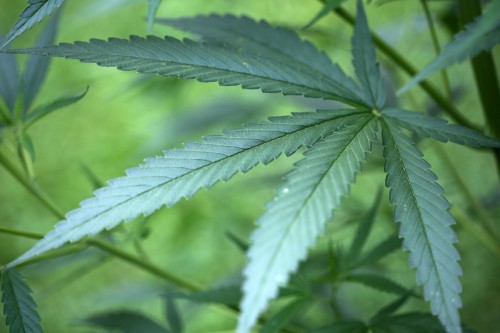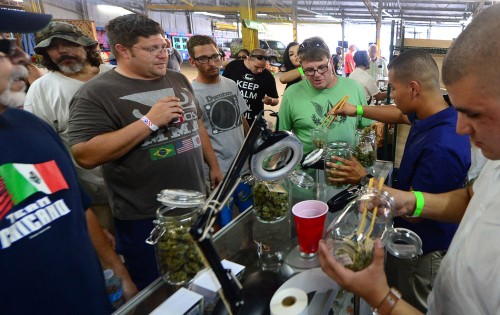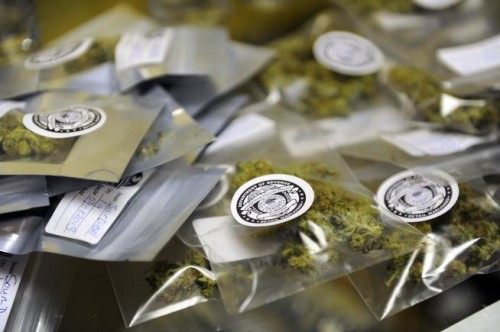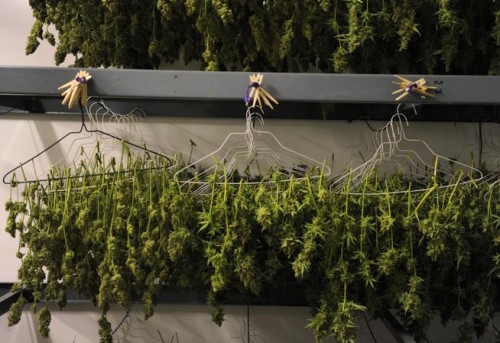For a seasoned cannabis user, it might seem a little strange that people are traveling to the emergency room for issues related to marijuana.
Unlike alcohol or pharmaceuticals — which bring hundreds of thousands to the ER each year — no one has ever died from cannabis use alone, a fact the federal government backs up. Overdosing on an edible or hash-dab can be a truly miserable experience, but currently the primary remedy in most cannabis cases is time and relaxation.
Marijuana and our health
CBD research: Two studies on CBD use for epilepsy show encouraging results
Editorial: In recreational states, it may be time to retire medical marijuana
Pediatrician: I would rather my kids choose marijuana instead of alcohol
NEW: Get podcasts of The Cannabist Show.
Subscribe to our newsletter here.
Watch The Cannabist Show.
So why go to the hospital?
Recent statistics show there has been a significant leap in the number of people showing up to the emergency room for marijuana — particularly in legalized states. Does this mean that the marijuana health epidemic prohibitionists warned us about has finally arrived? Or can all this be chalked up to inexperienced straights trying pot for the first time, freaking out and not knowing what to do other than go straight to the hospital?
“The most common reason someone goes to the ER for a marijuana reaction is anxiety,” says Dr. Larry Bedard, former president of the American College of Emergency Physicians, via phone. “Part of an anxiety reaction is you have an impending sense of doom. So a lot of people come in (to the hospital) thinking they’re dying, when they’re actually having a panic attack. That’s very common. If you’re smoking a joint and suddenly you can’t breathe and your chest feels tight and you start to get numb and tingly, you start to think you’ve been poisoned.
“What happens is you’re hyperventilating, which changes the pH of your blood, and you can get a form of tetany, and that’s why people get numb and tingly. So a lot of the time you have to slow their breathing down. Usually people just need reassurance, talking them down.”
This was seemingly the case last October when a 22-year-old from Ohio called 911 to say he was “too high” and “couldn’t feel anything,” later declining medical attention when police found him curled up with Doritos and cookies. Similarly, Maureen Dowd’s infamous edible nightmare in a Denver hotel had the New York Times columnist thinking, “I had died and no one was telling me.” After later realizing she’d ingested far too much of the THC-infused edible, Dowd noted “the fact that I was not a regular marijuana smoker made me more vulnerable, and I should have known better.”

Curiously, Bedard says that out in Marin County, California — where he was an emergency room physician for two decades — “we have one of the highest rates of marijuana-usage in California,” yet despite the high concentration of cannabis consumers, he adds that “in 20 years I saw less than ten patients who came in where their chief complaint was marijuana.”
It’s likely that the old-school cannathusiasts of Marin County were, for the most part, well practiced in the art of being high. This, combined with a hesitancy to admit to a doctor that you use illegal drugs, could explain why so few visited the hospital for marijuana problems.
Yet in Colorado and Washington, where legalized recreational marijuana has made converts of those who’ve never tried it (or haven’t in decades), doctors say these visits are a regular occurrence.
“We see multiple cases a day involving some sort of reaction to marijuana,” says Dr. Chris Colwell, chief of emergency medicine at Denver Health. “Whereas before (legalization), I’d go several days without seeing any of this.”
Useful weed resources
Strain reviews: Check out our marijuana reviews organized by type — sativas and sativa-dominant hybrids, ditto with indicas.
Favorite strains: 25 ranked reviews from our marijuana critics
Dr. Alexander Garrard of the Washington Poison Center (WAPC) says he’s seen a steady increase in the number of marijuana-related incidents in his state’s hospitals over the last 10 years, with large bumps often correlating with changes to cannabis laws, and areas with a high concentration of calls overlapping with those containing retail dispensaries.
“Because it is legal here, there is more product available,” says Garrard. “There are a large portion of adults that used marijuana 30 or 40 years ago, and want to try it now. But marijuana is much stronger today, so if you use the same amount now you did then you will likely have an adverse effect.”
While Washington technically legalized recreational marijuana in 2012, when they saw 162 calls to the poison center, the state’s dispensaries weren’t up and running until mid-2014, when that number rose to 245, according to Garrard. As of November 2015, there had been 238 calls to the poison center for issues directly related to marijuana.
Similarly, the Rocky Mountain Poison and Drug Center reports there were 127 calls for marijuana-related issues in Colorado in 2013, but that number increased to 223 in 2014. By October 2015, the center had seen 188 calls on the subject.
Both organizations note that while these numbers represent a trend, they are grossly under-representative, as they’re only cases where people or doctors call in to the poison center for assistance. Once a doctor knows how to handle the situation, he or she might stop calling to report the cases.
So why are we seeing an uptick in emergency room visits for pot now in Colorado and Washington, despite this never being an issue even in areas with heavy cannabis use in the past?

“There are a number of different reasons (for the increase),” says Garrard, via phone. “Because it is legal people are more comfortable calling, and there’s more product available now. … For 2015, a majority of the cases have been in the 13-to-19 age group, and that’s been consistent going back to 2012.”
Garrard says there is no data collected on whether or not patients have had any long-term experience with marijuana, though anecdotal reports suggest that it is the novices who seek out hospital services when they’re having a bad trip — and, by definition, most young people are inexperienced in pretty much everything.
The proliferation of edible marijuana products (cakes, cookies, sodas, etc.) — which was typically a novelty item for stoners in the past, but is now a well-marketed and tasty pillar of the industry — can also be an attractive alternative to smoking for novice users, who often commit the common mistake of eating the recommended dose, not feeling anything 20 minutes later, and then eating way too much.
So how do doctors respond to these situations?
In extreme cases, Bedard says it’s common to give a patient some kind of sedative, like Xanax or Valium (though if the patient also has alcohol in their system, these drugs are avoided as they can create actual life-threatening issues). In a majority of cases, though, it’s a matter of telling the patient that they aren’t dying and keeping an eye on them until they feel better — a service that could be accomplished by a friend or neighbor (who likely won’t send you a hefty bill weeks later).

Typically, adults aren’t admitted into the hospital strictly for marijuana complications; they are seen by doctors, but don’t stay the night, experts say. With kids and marijuana, though, it’s a different story — particularly when it comes to edibles.
“We are seeing more toddlers who are ingesting marijuana edibles (coming into the hospital),” says Dr. Suzan Mazor, director of toxicology at Seattle Children’s Hospital in an email interview. In her experience, she’s witnessed toddlers on edibles “who come in sleepy, almost comatose, wobbly, not able to hold his head up, not able to eat or drink normally, needing to stay in hospital for (intravenous) fluids and to be watched closely until he wakes up and is able to walk and feed.”
Mazor says that sedatives are not given to children in these instances, partially because they are often already extremely sleepy. She says the children have their heart and respiratory functions monitored, and may be given oxygen, IV fluids or anti-vomiting medicine.
So taking a child who has ingested cannabis to the emergency room is the right thing to do. Even though there are no reported cases of children dying from ingesting cannabis, the fragility of a child’s mind and body warrants professional monitoring while the marijuana passes through their system.
Protecting children from accidental marijuana exposure has been a common argument in the fight against the legalization of marijuana, and reported statistics — such as a July 2015 news release from health officials in King County, Washington, that noted a 73 percent increase in reported edible marijuana intoxication between 2013 and 2014 and that roughly 30 percent of reports in 2014 were for children age 5 or younger — are strong ammunition for these campaigns.
But stats like these often irk marijuana advocates, who believe they are not put in perspective.
Looking closer at the data provided by the Washington Poison Center, in 2014 there were 38 edible intoxication reports for adults and children in King County, Washington’s most populous county and home to Seattle; 11 were for children age 5 or younger. And these are the numbers of marijuana intoxications reported directly to WAPC — not the number of those admitted to the hospital.

“The numbers bear out that this is not a significant problem,” says Paul Armentano, deputy director for the National Organization for the Reform of Marijuana Laws (NORML), via phone. Armentano doesn’t think that this issue isn’t worth paying attention to, but he notes that “far more children are hospitalized for the inadvertent ingestion of those laundry detergent pods than for cannabis ingestion.”
Between 2012 and 2013, more than 17,000 children under 6 years old nationwide were injured due to ingestion of the candy-colored detergent packets.
Armentano also points out that often the data used in these campaigns can be misleading, like in the case of a Drug Abuse Warning Network study that showed 455,668 cases of U.S. emergency room visits for marijuana in 2011. That sounds like a lot, until you consider that not all of these incidents were directly related to marijuana — rather the patients had mentioned recently using marijuana.
“Fear sells in this country,” Armentano continues. “Fear can potentially bring in revenue in the form of grants, or increased attention and therefore funding. We’re talking about a product that has no risk of lethal overdose, and very little to any toxicity. Marijuana is used by tens of millions of Americans, in some cases on a daily basis, and we see very few instances of significant adverse side effects — there is no debate about that.”
One of those rare instances of adverse side effects from marijuana comes in the form of an ailment called cannabinoid hyperemesis syndrome (CHS), which has only been studied in recent years. First identified in 2004, there is still little known about CHS outside of three distinct factors: Heavy marijuana use, uncontrollable cyclic vomiting and relief experienced through compulsive showering or bathing. If these three variables are confirmed, a patient is typically diagnosed with CHS.
Like a child found munching on an edible with 100 milligrams of psychoactive cannabinoid THC, anyone stricken with ceaseless vomiting should definitely seek immediate medical treatment, doctors say. Cases of CHS are wildly different from Maureen Dowd’s temporary discomfort, primarily because their problem won’t go away in a matter of hours.
Dr. Jason Persoff of the University of Colorado Hospital Medicine Group says it can take a month of complete marijuana abstinence before the symptoms go away. “That’s a long time,” Persoff says via phone. “Most patients just don’t have the buy-in, due to conviction that marijuana is the cure and not the cause.”
It may seem odd that marijuana would alleviate nausea for so many medical marijuana patients yet cause violent fits of vomiting for others; yet what is known as a “paradoxical effect” is not unheard of in medicine. Some patients become hyper on sedatives or sleepy on stimulants; others experience increased pain on pain relievers. No one knows yet why cannabis affects some people with this condition, and Persoff says it’s common for patients to become offended when diagnosed.
“There’s a conviction that marijuana is the only thing that helps,” he explains. “And while we don’t fully understand the mechanism behind (cannabinoid) hyperemesis syndrome, my feeling is that it’s akin to a withdrawal phenomenon — like alcohol with fevers and shakes. … If it is a withdrawal phenomenon, then that would be a sign of physical addiction to marijuana.”
Due to CHS patients being prone to taking long, hot showers for nausea relief, Persoff says he will put these patients into a hospital shower and interview them about their condition — “which makes for a weird experience,” he says.
Bedard says that in 20 years of emergency medicine in California he never witnessed a patient with CHS, but admits that he has heard of cases of it in Colorado. “You only have so many endocannabinoid receptors in your body, and chronic heavy users may overwhelm the endocannabinoid receptors they have,” he theorizes.
Both Persoff and Colwell say they see a patient with CHS symptoms every day or two. There are a handful of studies on the subject and online forums where those suffering from CHS can share their stories.
“Some people come into the emergency department when they run out of hot water at home,” Colwell says. In extreme cases, Colwell will give patients “an atypical antipsychotic, which will relieve their symptoms better than anything else.”
One of the difficulties in diagnosing CHS is that there’s no clear definition of a “heavy marijuana user” in medical circles, and patients don’t often keep track of how much they consume.
“If someone says they use several times a day, is that taking a couple puffs, or smoking a couple joints? I have no idea what that means,” Persoff says. “If someone says they smoke half a pack of cigarettes a day, or drank five shots of 80-proof vodka, I know what that means.”
Colwell adds that these cases represent a small minority of the patients coming into the ER with issues related to marijuana, most of whom are never admitted to the hospital. “I would say, off the top of my head, that 98 percent of the patients we see related to marijuana get sent home from the emergency department.”
Until more studies are performed on the specifics of patients with CHS symptoms it is difficult for doctors to gain any clear understanding of how this condition occurs and what specific criteria should be used to diagnose it — other than the basic connection of vomiting, excessive showering and regular marijuana use.
“The science of marijuana is very difficult to come by,” Persoff says. “It is a complex compound of many different substances, and that can vary within the strain, how it’s prepared and how it’s ingested.”
Experts agree that increasing the knowledge base will be difficult to achieve while cannabis remains a Schedule I substance under federal law and research is heavily restricted, preventing studies from being done on the various forms of marijuana (both legal and black market) that millions of Americans are currently consuming.
Until that day, health professionals are unable to give clear answers on whether a patient’s symptoms are related to his or her cannabis use, and if they warrant a trip to the hospital. If you have a child in your care who got into your edibles (which, needless to say, should never be within their reach) or if you’re experiencing uncontrollable vomiting, a trip to the ER is in order.
If you as an adult are experiencing a bad trip on an unfamiliar edible or concentrate — or if you’re using for the first time in decades and aren’t used to these new super-strains of potent pot — going to the emergency room is a decision you have to make yourself.
Is your head suddenly racing with irrational thoughts? Try to calm yourself with the same reassuring advice an ER doc might very well share with you: No one has ever died from marijuana alone.
But if those thoughts delve into a particularly dark place, know that cannabis — like any psychoactive substance — can alter your brain chemistry and have negative interactions with existing mental conditions or other drugs in your system. If the emergency room seems like the right call, head on over and be as forthcoming with the medical staff as possible.
